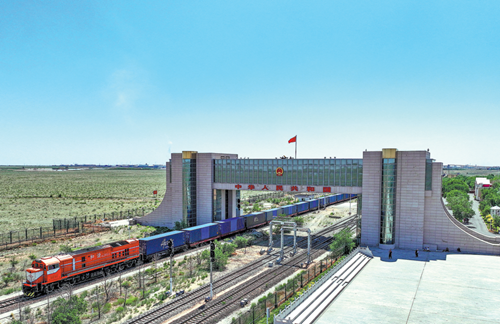
China and Mongolia are forging a powerful narrative of mutual benefit and win-win cooperation through a high-level platform for open collaboration, providing a boost to regional cooperation in Northeast Asia.
As close neighbors connected by mountains and rivers, China and Mongolia have enjoyed a growing comprehensive strategic partnership in recent years, guided by the strategic leadership of both nations' heads of state.
Political trust has deepened, economic and trade cooperation has flourished, and these developments have brought real benefits to the people of both countries, Yan Dong, vice-minister of commerce, told a news conference on the fifth China-Mongolia Expo, which concluded on Friday.
The five-day expo, which was held in Hohhot, Inner Mongolia autonomous region, drew nearly 6,000 guests and exhibitors from both domestic and international spheres, and brought together over 1,500 companies from around the world.
ALSO READ: China-Mongolia border port handles milestone 20,000 China-Europe freight trains
The participants included not only neighboring countries like Russia but also nations from South America and Africa, such as Brazil, Uruguay, Kenya, and Mozambique. The event highlights an ever-expanding network of international partners, according to organizers.
This year marks the 10th anniversary of the CME's inception. Over the past decade, the brand, scale, scope, and international influence of the expo have increased, playing a significant role in promoting China-Mongolia friendship, deepening cooperation in Northeast Asia and aiding the development of the China-Mongolia-Russia Economic Corridor, according to Yan.
Official data showed, in 2024, trade between China and Mongolia reached a high of $18.62 billion, up 10.1 percent year-on-year, exceeding the overall growth rate of China's foreign trade by 5 percentage points. China has maintained its status as Mongolia's largest trading partner, largest source of imports and primary export destination.

China's investment in Mongolia is steadily on the rise, leveraging its geographic proximity and deep-rooted connections. Both countries, with complementary strengths in critical minerals, infrastructure and agriculture, have unlocked immense cooperation potential. Joint efforts have broadened investment scopes, moving beyond traditional sectors like mining and livestock processing to include the digital economy and green energy.
Additionally, economic and technical cooperation is gaining momentum, with strides in cross-border economic zones, railways, and port infrastructure. Over the years, China has supported Mongolia in developing key infrastructure and livelihood projects, solidifying their bond and mutual growth.
Building on robust economic cooperation, the fruit and vegetable trade has emerged as a lifeline in China-Mongolia bilateral livelihood initiatives. Ereenhot Port, the largest land port on the China-Mongolia border, now caters to 80 percent of Mongolia's fruit and vegetable demand. The variety of exports has expanded significantly, featuring over 20 types of vegetables like cabbage, bell peppers and broccoli, as well as more than 10 different fruits including apples and bananas.
READ MORE: Mongolia issues bubonic plague warning after 22 dead marmots seized
Since the launch of the China-Mongolia agricultural products expedited clearance "green channel" at Ereenhot Port in 2018, Ereenhot Customs had overseen the export of approximately 800,000 metric tons of fruits and vegetables by the end of July 2025, official data showed. This has provided crucial support for the stable supply of fresh produce in Mongolia's markets.
To ensure the efficient delivery of fresh agricultural products to Mongolia, Ereenhot Customs has eliminated weekend and holiday clearance restrictions, utilized technologies such as smart loading and unloading supervision, instant sealing and nonintrusive inspection. These measures have minimized the retention time of fruits and vegetables, enabling immediate inspection and release upon arrival.
In addition to the fruit and vegetable trade, the intelligent upgrade of port infrastructure and equipment underscores the modernization of China-Mongolia trade.
For instance, at Ganqimaodu Port, the largest cargo port between China and Mongolia, automated guided vehicles are now in use, navigating busy routes in an orderly manner.

"AGVs are loaded with cargo at Mongolia's digital container port and navigate along specified routes via magnetic markers embedded in the ground," said Ge Lei, deputy section chief of a regulatory division under Hohhot Customs.
"These vehicles autonomously travel between the regulatory sites of China and Mongolia, with capabilities for automatic checkpoint clearance, autonomous loading and unloading operations, and automatic customs declaration for entry and exit."
In 2022, Ganqimaodu Port pioneered a new model of AGV cross-border cargo transportation in China.
In recent years, Ganqimaodu Port has strengthened its infrastructure, establishing intelligent checkpoints with 12 entry lanes and seven exit lanes, as well as dedicated AGV lanes with two entry and exit lanes.
Currently, 60 AGV trucks are in operation, with each vehicle's transport cycle taking approximately 80 minutes. The daily transport efficiency can be more than five times that of traditional vehicles, with a maximum daily capacity of up to 500 trips.
Meanwhile, as a core transportation link for China-Mongolia trade, China-Europe freight trains are using the Ereenhot railway port to achieve significant improvements in both volume and efficiency. This development highlights the region's growing importance in assisting international logistics and trade.
READ MORE: China and Mongolia begin work on a new cross-border railway
In May 2025, construction began on the Ganqimaodu-Gashuun Sukhait cross-border railway, the second such crossing between China and Mongolia in nearly 70 years.
The railway is scheduled to be completed and operational by 2027. After that, it is expected to handle an annual cargo volume of 30 million tons, driving upgrades in cross-border logistics, industrial parks, and border services between the two countries.
This will expand China-Mongolia cooperation in key areas such as trade, energy resources, and connectivity and serve to align the Belt and Road Initiative with Mongolia's Steppe Road Program.
Over the past decade, Inner Mongolia has continually deepened its cooperation with Mongolia in areas such as infrastructure connectivity, said Yang Jin, vice-chairman of the Inner Mongolia autonomous region.
A new multidimensional and integrated port opening pattern has emerged, encompassing roadways, railways and aviation. This has significantly widened and streamlined China's northern gateway, ensuring smooth and unobstructed passage, Yang said.


